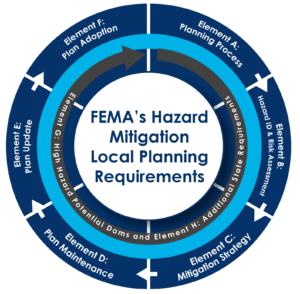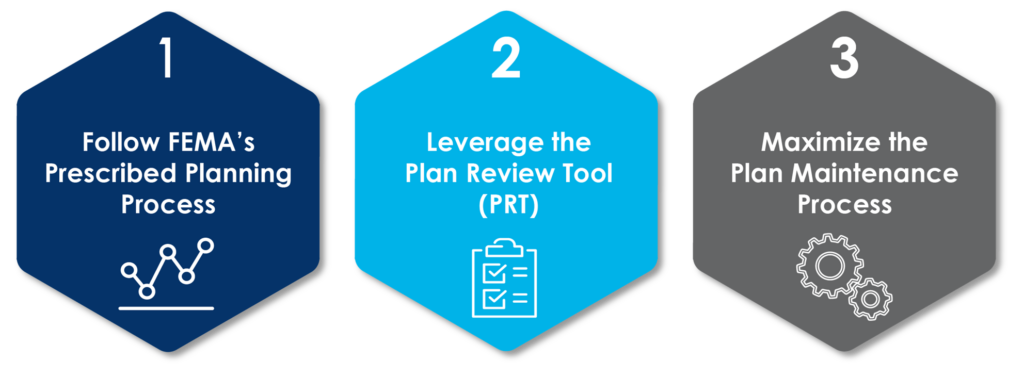Note: The following blog is an excerpt of a more extensive White Paper containing additional information. Please email info@constantassociates.com should you be interested in receiving the White Paper.
Overview
As disasters grow more frequent and severe, it is critical to have a robust plan to identify hazards, craft risk-reduction strategies, coordinate resources, and raise public awareness. Developing a Hazard Mitigation Plan (HMP) enhances resilience by prioritizing actions to protect the community and its assets. The HMP process involves whole community participation, integrating governmental and non-governmental organizations and community stakeholders.
Local communities must update and approve their HMP every five (5) years to remain eligible to receive Hazard Mitigation Assistance grant funding per the Disaster Mitigation Act (DMA). This places significant responsibility on local emergency management personnel and agencies to remain up to date on State and Federal Emergency
Management Agency (FEMA) requirements.
FEMA’s Local Mitigation Planning Policy Guide has been updated, effective April 19, 2023. As is described below, the Policy Guide features key changes in areas like stakeholder and community engagement that have made the HMP update process more inclusive, robust, and foresighted. While this brings benefits for each community and the broader nation, agencies and contractors alike have found it challenging to navigate the revised requirements in the first year of implementation.
However, CONSTANT has thoroughly reviewed the new Policy Guide, participated in multiple training courses facilitated by hazard mitigation experts, and received approval for several HMPs under the updated guidance. Through this experience, we share the following tips for jurisdictions initiating an HMP update.
Tip 1: Follow FEMA’s Prescribed Planning Process
 In FEMA’s Local Mitigation Planning Policy Guide, Element A describes the planning process that should be followed to update an HMP. When assessing an HMP for approval, FEMA and State Governments use the Local Mitigation PRT to evaluate HMP content by element against regulation in 44 Code of Federal Regulations (CFR) § 201.6 and determine if a requirement has been met. This means that local jurisdictions can also use the PRT as a checklist. The required elements in the PRT include the following outlined as A-F in the figure, with elements G-H representing High Hazard Potential Dams (HHPD) and Additional State Requirements, if applicable. Using the planning process provides assurance of compliance with, and incorporation of, all national laws, regulations, Executive Orders (EO), Presidential Policy Directives (PPDs), doctrine, and policy.
In FEMA’s Local Mitigation Planning Policy Guide, Element A describes the planning process that should be followed to update an HMP. When assessing an HMP for approval, FEMA and State Governments use the Local Mitigation PRT to evaluate HMP content by element against regulation in 44 Code of Federal Regulations (CFR) § 201.6 and determine if a requirement has been met. This means that local jurisdictions can also use the PRT as a checklist. The required elements in the PRT include the following outlined as A-F in the figure, with elements G-H representing High Hazard Potential Dams (HHPD) and Additional State Requirements, if applicable. Using the planning process provides assurance of compliance with, and incorporation of, all national laws, regulations, Executive Orders (EO), Presidential Policy Directives (PPDs), doctrine, and policy.
There are several nuances required for HMP updates integrated in FEMA’s prescribed planning process that were not a key feature of previous guidance. Other nuances carry over from prior guidance but may have been expanded. We spotlight these as key elements to ensure alignment with requirements and a streamlined approval process, including:
- Prioritize Stakeholder Engagement
- Integrate Equitable Public Involvement
- Develop Robust Hazard Profiles that Address the Impacts of Climate Change
- Strengthen the Mitigation Strategy
Prioritize Stakeholder Engagement
A key element of the HMP process is identifying and engaging a Planning Committee that provides guidance, feedback, and local insights on needs, resources, structures, recent events, and relationships. Engaging stakeholders in the HMP process begins with formal invitations. When distributing these invitations for participation in the Planning Committee, candidates for engagement include local, county, state, and federal agencies and departments, neighboring communities, business leaders and employers, academia, community leaders, elected officials, participating special districts, school districts, universities, and colleges, health providers, cultural hubs, neighborhood associations, and other private and non-profit interests. This wide cast of stakeholders ensures that those engaged includes those involved in hazard mitigation activities; those with the authority to regulate development; neighboring communities who may share projects or be partners in response; those that sustain community lifelines; and those that provide support to underserved communities.
A series of Planning Committee Meetings must be held to support and inform the planning process. These meetings should be expertly organized, documented, and facilitated to provide proper documentation of the planning process. Proper documentation emphasizes recording decisions and decision-makers. Discussions during Planning Committee meetings will span topics like plan goals and objectives, identification and prioritization of hazards, identification of goals and strategies for hazard mitigation, climate change mitigation, plan implementation, plan maintenance, and review of plan drafts. CONSTANT recommends at least four (4) Planning Committee meetings to meet FEMA regulations.
Integrate Equitable Public Involvement
Involving the public is a substantial component of the HMP process and a critical reason why revisions have been requested under the new guidelines. It is also a key reason for misunderstanding HMP goals and the development timeline. FEMA requires public involvement during plan development and prior to plan approval.
A comprehensive public engagement strategy informs the HMP and provides platforms for input. In addition to invitations to the Planning Committee meetings, we recommend a series of in-person or virtual public meetings and use of government websites, press releases, social media posts, physical outreach materials, direct outreach, presentations, roundtable discussions, dashboards, and surveys to comprise the engagement strategy. Talking points and messages should be personalized to audiences.
Develop Robust Hazard Profiles that Address the Impacts of Climate Change
An updated HMP must include data validation for each natural hazard, which means that the data collection requirements for hazard identification and profiling is a significant effort. This involves developing concise profiles of potential hazards, noting their type, location, extent, previous occurrences, future probability, community vulnerability and impact, regulatory environment, and other factors required by DMA 2000.
Furthermore, FEMA’s updated guidelines require that the HMP considers the probability of future natural hazard events and reflects changes in population patterns and land use and development. Climate change is currently facilitating strengthened frequency and
extremity of several hazards. As such, climate change must be addressed in the risk assessment when examining hazard probability, vulnerabilities, and impacts with the mitigation strategy outlining appropriate adaptation actions.
Strengthen the Mitigation Strategy
As risk, vulnerability, and capabilities assessments are developed to inform the HMP, the hazard mitigation goal selection and mitigation strategy development processes begin. FEMA requires that any known prior hazard mitigation activities are identified, and their statuses updated, whether the activities have been completed, deleted, or deferred.
There must be at least one (1) mitigation action identified for each hazard, and the Mitigation Plan or “Action Plan” can evaluate and prioritize mitigation actions/strategies using a method such as the Social, Technical, Administrative, Political, Legal, Economic, and Environmental Matrix (STAPLE + E).
Actions should specifically address vulnerabilities identified in the risk assessment. Local jurisdictions should implement mitigation actions through existing plans and policies that already have support from the community and policy makers, and consider how existing authorities, policies, programs, funding, and resources can support implementation.
Tip 2: Leverage the Review Tool for Plan Approval
In preparing a draft HMP, CONSTANT compiles all required materials including the hazard analysis, capabilities, documentation of the planning process, maps, risk assessment, and mitigation goals to author a plan that adheres to FEMA plan guidance. As an initial draft
is compiled, there is an opportunity to crosswalk an HMP against the PRT to ensure all plan elements are satisfied. This is the process undertaken by State and FEMA Mitigation Planners as they seek to provide feedback to local governments.
As CONSTANT has had multiple HMPs approved under FEMA’s updated guidelines, we provide the following insights:
- Include details of how the public was involved, including their opportunities to participate, how underserved communities and vulnerable populations were targeted, and how the public feedback was used in the HMP development.
- Identify if hazards make sense for the geographical area and align with past plans and provide a rational for omitting hazards not included in the plan.
- Elaborate if the plan shows a range of anticipated intensities of the identified hazards. The extent is most commonly expressed using various scientific scales.
- Describe the likelihood of the hazard occurring or reoccurring. The hazard may be defined in terms of historical frequencies, statistical probabilities, hazard probability maps and/or general descriptors.
- The risk assessment must describe the vulnerability of plan participant(s) to each identified hazard. The vulnerability description must include a summary of the hazard and its consequences or effects on the participant(s) and their assets. Vulnerability is a description of which assets, including structures, systems, populations and other assets as defined by the community, within locations identified to be hazard prone are at risk from the effects of the identified hazard(s).
- Impacts must include the effects of climate change, changes in population patterns (migration, density, or the makeup of socially vulnerable populations), and changes in land use and development. Impacts are the consequences or effects of each hazard on the participant’s assets identified in the vulnerability assessment.
Tip 3: Maximize the Plan Maintenance Process
To maximize the impact of the HMP, the plan must be continually maintained and updated, both as required by the five (5) year cycle and as progress, roadblocks, or changing circumstances are recognized. Under FEMA’s Element D within the Local Mitigation Policy Guide, there must be a description of the method and schedule for
keeping the plan current and a description of how the community will continue public participation in the plan maintenance process.
Plan maintenance incorporates three (3) steps – monitoring, evaluating, and updating:
- Monitoring: The ongoing process by which stakeholders obtain feedback on progress made towards achieving goals. A monitoring report should be written following major meetings to report on the progress of mitigation projects/actions from start to finish. Situational change (i.e., plan changes due to training or exercises, project completions, and hazard events) can also trigger a monitoring report.
- Evaluating: Following a hazard event, training, exercise, or change or completion of a mitigation project, there is an opportunity to assess activities to determine whether they are achieving objectives. An evaluation report formalizes an assessment.
- Updating: Per FEMA guidelines, a formal HMP update must occur every five (5) years. However, an update could also be initiated upon completion of an evaluation report, if appropriate, and/or as new hazard data becomes available.
The plan maintenance process continues to advance in sophistication, but this provides an opportunity for jurisdictions to capitalize in a meaningful way on the work, relationships, actions, and investment in the HMP process and to further community resilience.
One such way to enhance the maintenance process is usage of custom software solutions to track mitigation activities. These can be modified to your jurisdiction’s existing systems for collaboration. For example, should your jurisdiction use the Microsoft suite, automations can be crafted in Power Automate to set reminders to update mitigation activities, populate databases based on form entries, and more.
Conclusion
BOTTOM LINE! Stronger planning processes produce better plans, which are easier and faster to review and result in quicker approvals by States and FEMA. Following FEMA’s prescribed planning process and leveraging the PRT can help your jurisdiction ensure alignment from the start.
Should your jurisdiction require assistance with updating or developing a local or multijurisdictional HMP, contact CONSTANT. Our State and Local Emergency Management Portfolio Manager, Mona Bontty, can be reached at Mona.Bontty@constantassociates.com. Our team is ready to apply our expertise to your plan to inform an actionable HMP

